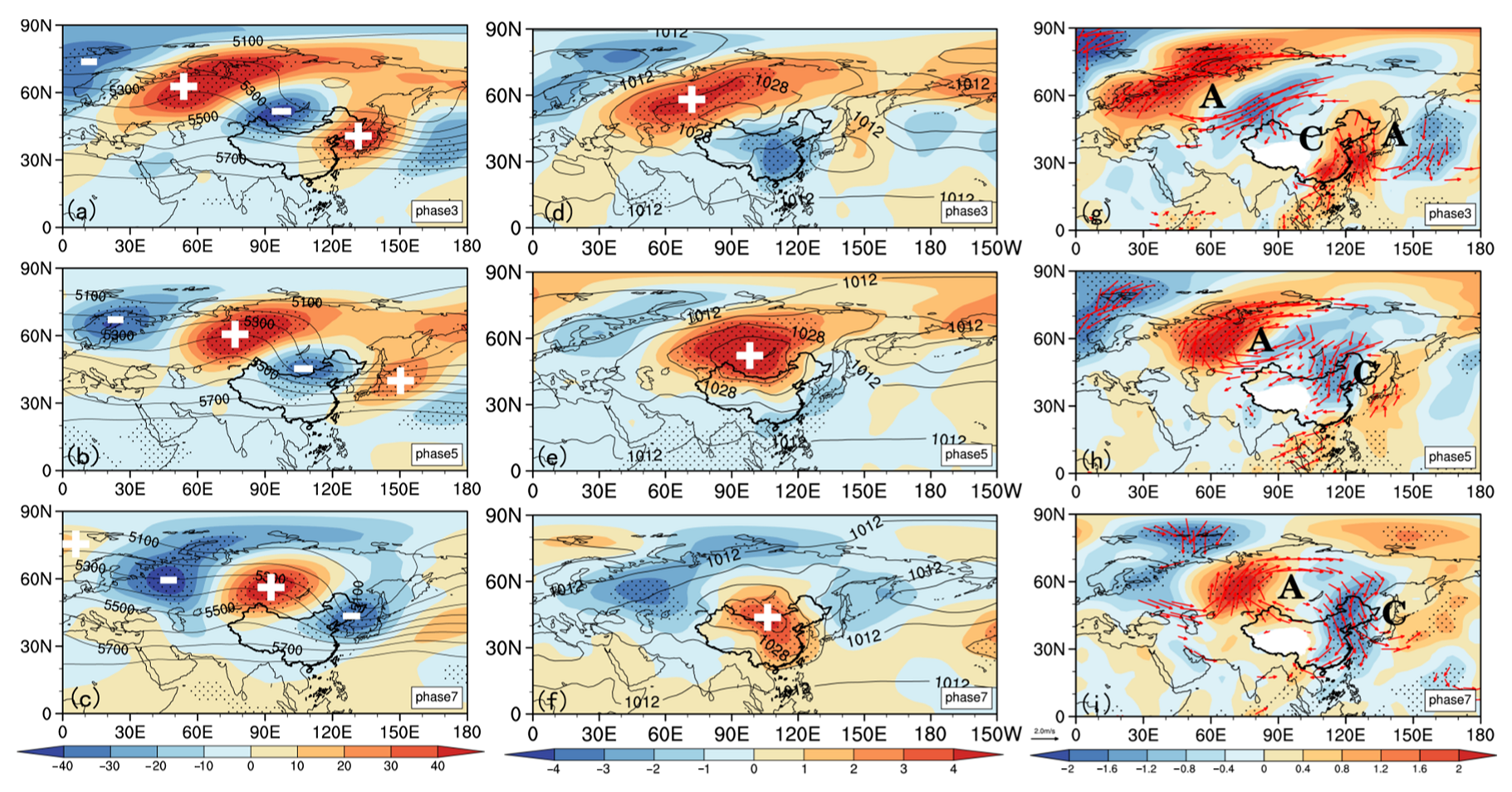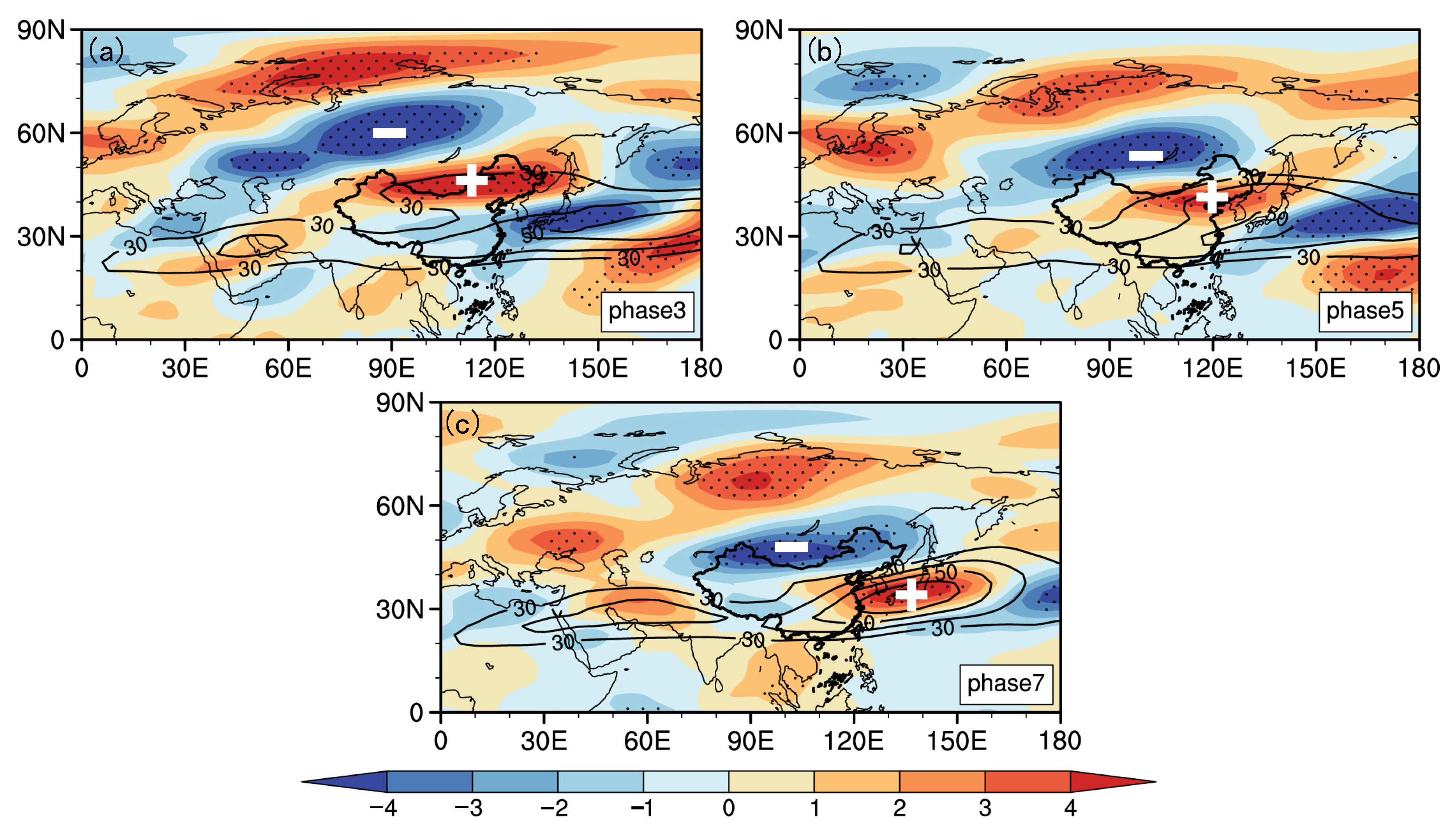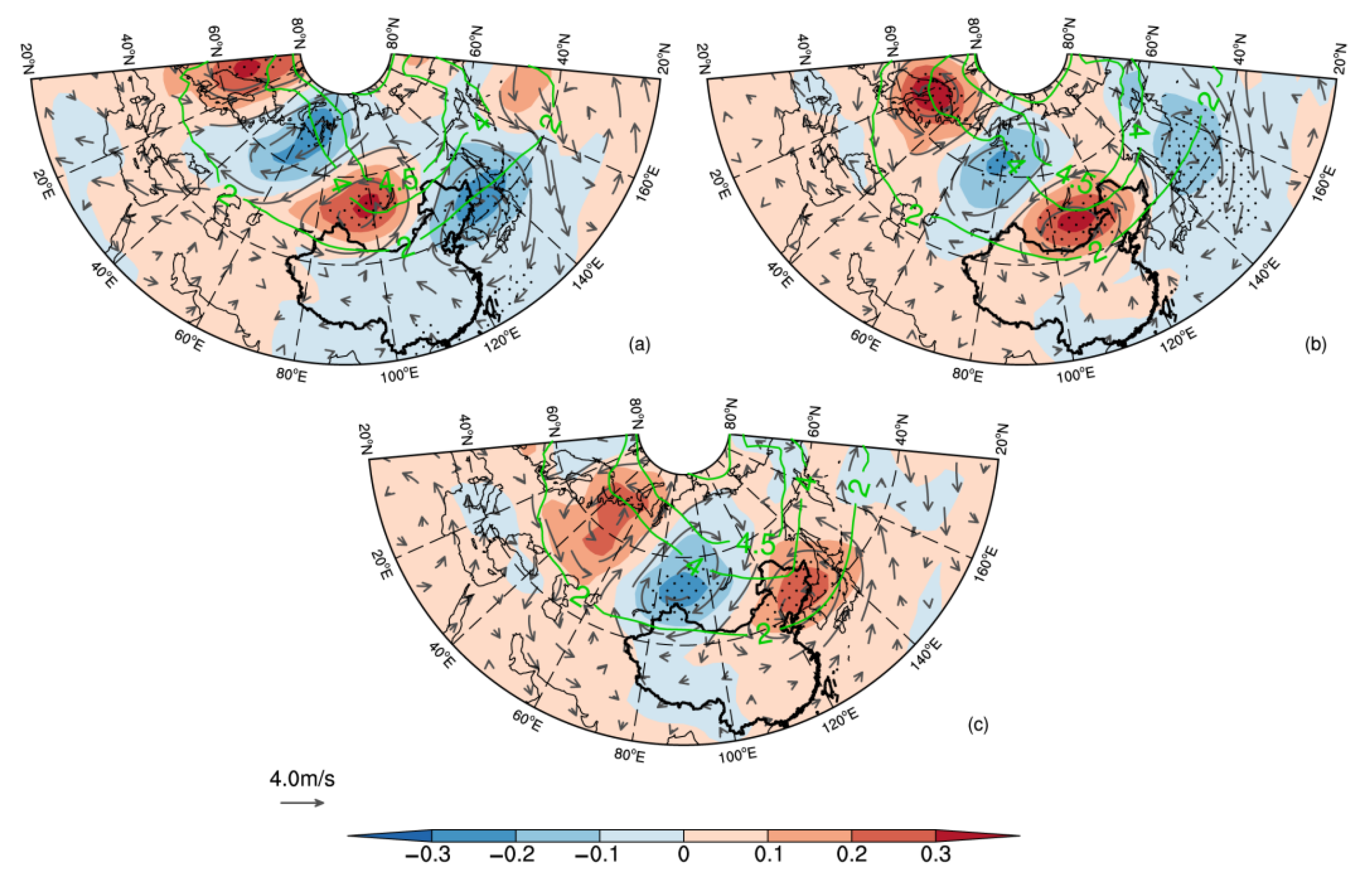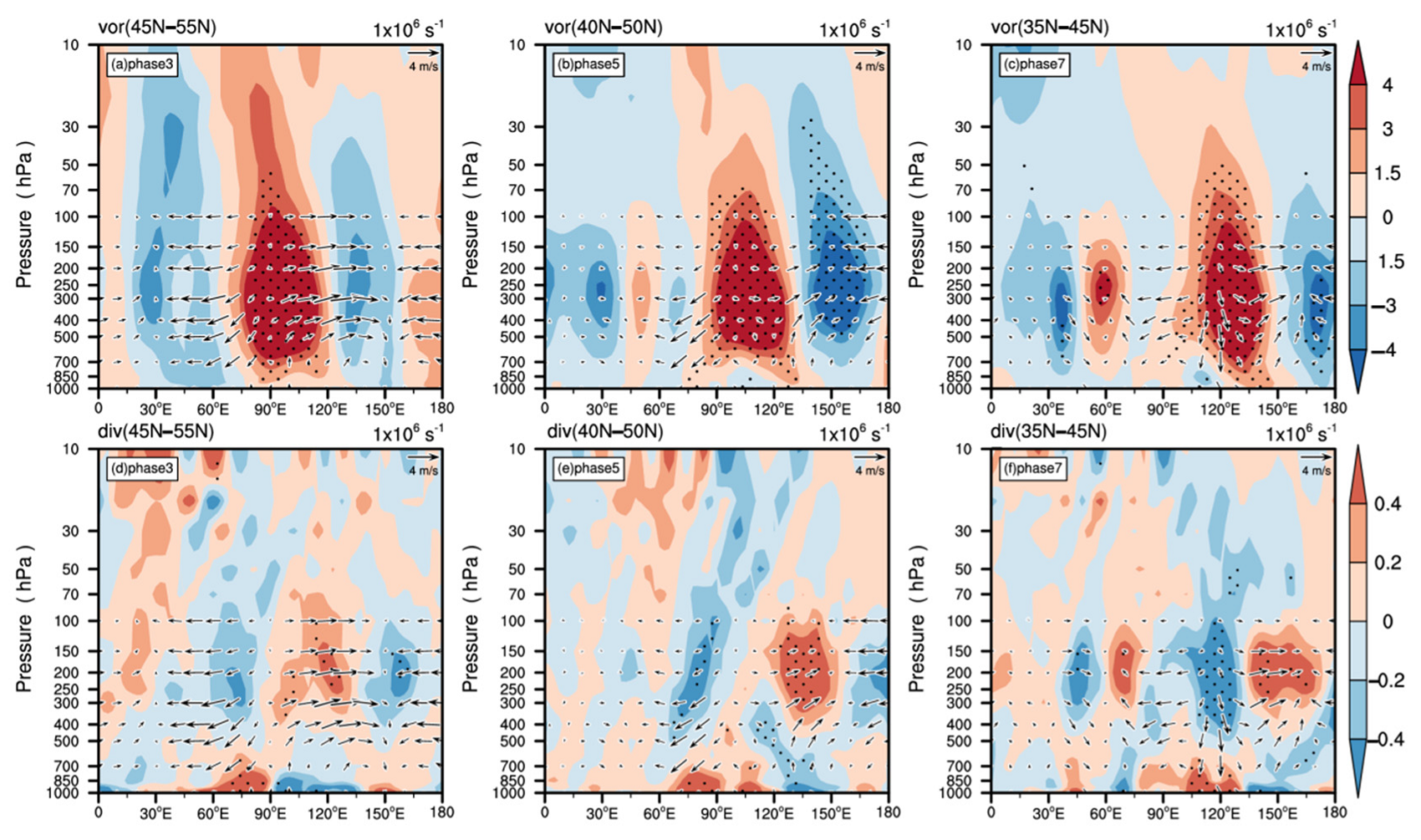Influence of Atmospheric 10–20 Day Low Frequency Oscillation on Regional Strong Cooling Events in the Winter of Northern China over the Past 40 Years
Abstract
:1. Introduction
2. Data and Methods
2.1. Data
2.2. Methods
2.2.1. Definition of RSCE
2.2.2. Morlet Wavelet Analysis
2.2.3. Butterworth Band-Pass Filter
2.2.4. Composite Analysis and Its t-Test
2.2.5. Lead-Lag Correlation Analysis
3. Results
3.1. Characteristic of RSCEs in Northern China
3.1.1. Spatial and Temporal Characteristics
3.1.2. Significant Low Frequency Periods
3.2. Association of RSCEs in Winter with Atmospheric LFO
3.2.1. Characteristics of Low Frequency Circulation in the Middle and Lower Troposphere
3.2.2. Characteristics of Low Frequency Jets
3.3. Characteristics of Low Frequency PV
3.3.1. Characteristics of Low Frequency PV Anomalies in the Tropopause
3.3.2. Characteristics of the Downward Propagation of Low Frequency PV Anomaly in the Upper Level of the Troposphere
3.4. Dynamic Characteristics of Low Frequency Circulation Vertical Structure
3.5. Low Frequency Prediction Signals
4. Discussion
5. Conclusions
Author Contributions
Funding
Data Availability Statement
Acknowledgments
Conflicts of Interest
References
- IPCC. Climate Change 2021: The Physical Science Basis. 2011. Available online: https://www.ipcc.ch/report/ar6/wg1/downloads/report/IPCC_AR6_WGI_Full_Report.pdf (accessed on 6 August 2021).
- Wang, Z.Y.; Ding, Y.H. Climate Change of the Cold Wave Frequency of China in the Last 53 Years and the Possible Reasons. Chin. J. Atmos. Sci. 2006, 30, 1068–1076. [Google Scholar] [CrossRef]
- Ding, Y.H.; Li, Q.P.; Liu, Y.J.; Zhang, L.; Song, Y.F.; Zhang, J. Atmospheric Aerosols, Air Pollution and Climate Change. Meteorol. Mon. 2009, 35, 3–14. [Google Scholar] [CrossRef]
- Huang, H.Q.; Han, X. Variation trend analysis of the cold airs in the East Asian. Mar. Forecast. 2014, 31, 69–75. [Google Scholar] [CrossRef]
- Zhou, L.; Sun, Z.B. Activity characteristics of cold air in China from 1961 to 2010. Trans. Atmos. Sci. 2015, 38, 342–353. (In Chinese) [Google Scholar] [CrossRef]
- Li, L.P.; Ni, W.J.; Li, Y.G.; Guo, D.; Gao, H. Impacts of Sea Surface Temperature and Atmospheric Teleconnection Patterns in the Northern Mid-Latitudes on Winter Extremely Cold Events in North China. Adv. Meteorol. 2021, 2021, 1–15. [Google Scholar] [CrossRef]
- Zhu, W.L.; Lin, Q.Q.; Wang, Z.Z.; Shen, X.Y. Climatological variability of cold air processes over China in recent 60 years. Meteorol. Mon. 2022, 48, 1–13. [Google Scholar] [CrossRef]
- Yang, Q.M. Study of the method of the extended-range forecast for the low frequency rainfall over the lower reaches of the Yangtze River in summer based on the 20–30 day oscillation. Acta Meteorol. Sin. 2014, 3, 494–507. [Google Scholar] [CrossRef]
- Li, X.; Wang, S.G.; Shang, K.G.; Zhou, H.; Li, Y. Extended range weather forecasting based on lunar-solar calendar superposition. J. Lanzhou Univ. Nat. Sci. 2015, 51, 526–530. [Google Scholar] [CrossRef]
- Ding, Y.H. Advanced Synoptic Meteorology; China Meteorological Press: Beijing, China, 1991; pp. 328–330. (In Chinese) [Google Scholar]
- Zhu, Q.G.; Lin, J.R.; Shou, S.W.; Tang, D.S. Principles and Methods of Synoptic Meteorology; China Meteorological Press: Beijing, China, 1992; pp. 377–418. [Google Scholar]
- Miao, Q.; Gong, Y.F.; Bai, Z.B. Characteristics of low frequency oscillations during cold waves in winter 2011/2012 and its coupling with the low frequency system at 500 hPa. Trans. Atmos. Sci. 2016, 39, 608–619. (In Chinese) [Google Scholar] [CrossRef]
- Ma, X.Q.; Ding, Y.H.; Xu, H.M.; He, J.H. The Relation between Strong Cold Waves and Low frequency Waves During the Winter of 2004/2005. Chin. J. Atmos. Sci. 2008, 32, 380–394. [Google Scholar] [CrossRef]
- Sun, C.H.; Ren, F.M.; Zhou, B.; Gong, Z.Q.; Zuo, J.Q.; Guo, Y.J. Features and possible causes for the low temperature in winter 2011/2012. Meteorol. Mon. 2012, 38, 884–889. [Google Scholar] [CrossRef]
- Guo, G.F.; Zhou, Y.H.; Gao, Z.X.; Du, L.M. Exploration of possible causes for the low temperature throughout the winter of 2011 in Yangtze River basin. Torrential Rain Disasters 2013, 32, 176–181. [Google Scholar] [CrossRef]
- Shen, H.Y.; Ding, Y.G.; Zhang, J. Inter-decadal variations of winter air temperature in north China and its circulation background. Sci. Meteorol. Sin. 2010, 30, 338–343. [Google Scholar] [CrossRef]
- Zhu, H.X.; Chen, W.; Feng, T. Interannual variations of Siberian High during boreal winter and its influence on East Asian temperature. Plateau Meteorol. 2019, 38, 685–692. [Google Scholar] [CrossRef]
- Gong, D.Y.; Zhu, J.H.; Wang, S.W. The Influence of Siberian High on Large-scale Climate over Continental Asia. Plateau Meteorol. 2002, 21, 8–14. [Google Scholar] [CrossRef]
- Lan, L.R.; Li, D.L. Interannual and interdecadal anomaly features of Siberian High and their impact on winter temperature of China. Plateau Meteorol. 2016, 35, 662–674. [Google Scholar] [CrossRef]
- Yao, H.R.; Li, D.L. The relationship between Asian jets and the winter monsoon and their impact on climate in China. Acta Meteorol. Sin. 2013, 71, 429–439. [Google Scholar] [CrossRef]
- Zhang, C.Y.; Zhang, Y.C. The characteristics of East Asian jet stream in severe snow storm and freezing rain processes over southern China in early 2008. J. Trop. Meteorol. 2013, 29, 306–314. [Google Scholar] [CrossRef]
- Ye, D.; Zhang, Y.C. Association of concurrent variation between the East Asian polar front and subtropical jets with winter cold air activity in China. Chin. J. Atmos. Sci. 2014, 38, 146–158. (In Chinese) [Google Scholar] [CrossRef]
- Ding, Y.H.; Liang, P. Extended Range Forecast Basing on MJO. Meteorol. Mon. 2010, 36, 111–122. [Google Scholar] [CrossRef]
- Li, C.Y. Atmospheric Low Frequency Oscillations; China Meteorological Press: Beijing, China, 1993. [Google Scholar]
- Matthews, A.J.; Hoskins, B.J.; Masutani, M. The global response to tropical heating in the Madden-Julian Oscillation during Northern winter. Q. J. R. Meteorol. Soc. 2004, 130, 1991–2011. [Google Scholar] [CrossRef]
- Zhu, Y.J.; Jiang, J. The intraseasonal characteristics of wintertime persistent cold anomaly in China and the role of low frequency oscillation in the low latitude and midlatitude. J. Trop. Meteorol. 2013, 29, 649–655. [Google Scholar] [CrossRef]
- Zhang, W.; Jiang, J. Influence of Madden-Julian Oscillation on winter persistent cold events in China. J. Meteorol. Sci. 2015, 35, 422–429. [Google Scholar] [CrossRef]
- Murakami, T. Winter Monsoonal surges over East and Southeast Asia. J. Meteorol. Soc. Japan. Ser. II 1979, 57, 133–158. [Google Scholar] [CrossRef]
- Jin, Z.H.; Sun, S.Q. The characteristics of low frequency oscillations in winter monsoon over the eastern Asia. Sci. Atmos. Sin. 1996, 20, 101–111. [Google Scholar] [CrossRef]
- Qi, D.M.; Li, Y.Q.; Chen, Y.R.; De, Q. Submonthly timescales oscillation characteristics of the east Asian winter monsoon and its effect on the temperature in southwest China-a case study in 2010. J. Trop. Meteorol. 2016, 32, 19–30. [Google Scholar] [CrossRef]
- Yang, S.; Zhu, Q.G. Oscillation and its Relation to Cold air Activities in Asian Winter. J. Nanjing Inst. Meteorol. 1990, 13, 339–347. [Google Scholar] [CrossRef]
- Ma, N.; He, L.Y.; Liang, S.J.; Guo, J. Low frequency characteristics of winter-time cold air activity in the Beijing-Tianjin-Hebei region and the impacts of low frequency variation of the Siberian High. Acta Geogr. Sin. 2020, 75, 485–496. [Google Scholar] [CrossRef]
- Ding, Y.H. The propagation of the winter monsoon during clod air outbreaks in east Asia and the associated planetary-scale effect. J. Appl. Meteorol. Sci. 1991, 2, 124–132. [Google Scholar]
- Suo, M.Q.; Ding, Y.H.; Wang, Z.Y. Relationship between Rossby wave propagation in southern branch of westerlies and the formation of the southern branch trough in wintertime. J. Appl. Meteorol. Sci. 2008, 19, 731–740. [Google Scholar] [CrossRef]
- Yang, Q.M. Extended-Range Forecast for the Low frequency Oscillation of Temperature and Low-Temperature Weather over the Lower Reaches of the Yangtze River in Winter. Chin. J. Atmos. Sci. 2021, 45, 21–36. (In Chinese) [Google Scholar] [CrossRef]
- Kim, B.M.; Lim, G.H.; Kim, K.Y. A new look at the midlatitude MJO teleconnection in the Northern Hemisphere winter. Q. J. R. Meteorol. Soc. 2016, 132, 485–503. [Google Scholar] [CrossRef]
- Miao, Q.; Gong, Y.F.; Deng, R.J.; Wei, N.W. Impacts of the low frequency oscillation over the extra-tropics of the Northern Hemisphere on the extreme low temperature event in Northeast China in the winter of 2012/2013. Chin. J. Atmos. Sci. 2016, 40, 817–830. (In Chinese) [Google Scholar] [CrossRef]
- Liu, Y.; Guo, P.W.; Feng, T. The relationship between winter persistent abnormal low temperature in North China and atmospheric low frequency oscillation activities. Trans. Atmos. Sci. 2016, 39, 370–380. (In Chinese) [Google Scholar] [CrossRef]
- Jiang, Y.F.; Yao, S.X.; Wang, Y.Q.; Zhang, X.N. Intra-seasonal oscillation characteristics of low temperature events in January 2016. J. Meteorol. Sci. 2019, 39, 42–49. [Google Scholar] [CrossRef]
- United Nations. “Transforming Our World: The 2030 Agenda for Sustainable Development”. United Nations General Assembly; Seventieth Session; United Nations: New York, NY, USA, 2015. [Google Scholar]
- United Nations. The Sustainable Development Goals Report 2018. 2018. Available online: https://unstats.un.org/sdgs/report/2018 (accessed on 20 June 2018).
- Varotsos, C.A.; Cracknell, A.P. Remote Sensing Letters contribution to the success of the Sustainable Development Goals—UN 2030 agenda. Remote Sens. Lett. 2020, 11, 715–719. [Google Scholar] [CrossRef]
- Robert, K.; Eugenia, K.; William, C. The NCEP–NCAR 50-year reanalysis: Monthly means CD-ROM and Documentation. Bull. Am. Meteorol. Soc. 2001, 82, 247–268. [Google Scholar] [CrossRef]
- Torrence, C.; Compo, G.P. A Practical guide to wavelet analysis. Bull. Am. Meteorol. Soc. 1998, 79, 61–78. [Google Scholar] [CrossRef]
- Murakami, M. Analysis of deep convective activity over the western Pacific and Southeast Asia. Part II: Seasonal and intraseasonal variation during the northern summer. Meteorol. Soc. Jpn. 1984, 62, 88–108. [Google Scholar] [CrossRef]
- Maloney, E.D.; Hartmann, D.L. Frictional Moisture Convergence in a Composite Life Cycle of the Madden-Julian Oscillation. J. Clim. 1998, 11, 2387–2403. [Google Scholar] [CrossRef]
- Mao, J.Y.; Chan, J.C.L. Intraseasonal variability of the South China Sea summer monsoon. J. Clim. 2005, 18, 2388–2402. [Google Scholar] [CrossRef]
- Wei, F.Y. Modern Climate Statistical Diagnosis and Prediction Techniques; China Meteorological Press: Beijing, China, 2007. [Google Scholar]
- Davis, R.E. Predictability of sea surface temperature and sea level pressure anomalies over the North Pacific Ocean. J. Phys. Oceanogr. 1976, 6, 249–266. [Google Scholar] [CrossRef]
- Chen, W.Y. Fluctuations in Northern Hemisphere 700 mb height field associated with the Southern Oscillation. Mon. Weather Rev. 1982, 110, 808–823. [Google Scholar] [CrossRef]
- Shi, N. Multivariate Analysis Methods in Meteorological Research and Forecasting, 2nd ed.; China Meteorological Press: Beijing, China, 2002. [Google Scholar]
- Li, G.; Li, C.Y.; Tan, Y.K.; Bai, T. Principal modes of the boreal wintertime SSTA in the South Pacific and their relationships with the ENSO. Acta Oceanol. Sin. 2012, 34, 48–56. [Google Scholar]
- Huang, W.Y.; Dong, W.; Shen, X.Y.; Guo, C.Y.; Li, X.F.; Liang, P. Isentropic vortex and thermodynamic analysis of a cold wave cooling process. J. Meteorol. Sci. 2020, 40, 769–781. [Google Scholar] [CrossRef]
- Chang, C.P.; Lau, K.M. Northeasterly cold surges and near-equatorial disturbances over the winter MONEX area during December 1974. Part II: Planetary-scale aspects. Mon. Wea. Rev. 1980, 108, 298–312. [Google Scholar] [CrossRef]
- Gao, S.T.; Tao, S.Y.; Ding, Y.H. Upper Wave-East Asian Jet Interaction during the Period of Cold Wave Outbreak. Chin. J. Atmos. Sci. 1992, 16, 718–724. [Google Scholar] [CrossRef]
- Zhao, L.; Ding, Y.H. Potential vorticity analysis of cold air activities during the East Asian summer monsoon. Chin. J. Atmos. Sci. 2009, 33, 359–374. (In Chinese) [Google Scholar] [CrossRef]
- Hu, B.W. Some Opinions about the “Potential Vorticity Thinking” and Its Applications. J. Nanjing Inst. Meteorol. 2003, 26, 111–115. [Google Scholar] [CrossRef]
- Ding, Y.H.; Ma, X.Q. Analysis of isentropic potential vorticity for a strong cold wave in 2004/2005 Winter. Acta Meteorol. Sin. 2007, 65, 695–707. [Google Scholar] [CrossRef]
- Xie, R.Q.; Liu, Y.D.; Zhu, J.S.; Meng, T. Analysis of Isentropic Potential Vorticity for an Extreme Cold Wave Event. Meteorol. Sci. Technol. 2019, 47, 312–321. [Google Scholar] [CrossRef]
- Zhang, C.; Shen, X.Y.; Zhang, L.; Guo, C.Y.; Li, X.F. The dynamical cause of cold dome’s intensification in a cold wave processes. Plateau Meteorol. 2021, 40, 394–402. [Google Scholar] [CrossRef]
- Hoskins, B.J.; McIntyre, M.E.; Robertson, A.W. On the use and significance of isentropic potential vorticity maps. Quart. J. Roy. Meteor. Soc. 1985, 111, 877–946. [Google Scholar] [CrossRef]
- Zhao, Q.G. An analysis with isentropic potential vorticity on a cold wave entering the Qinghai-Xizang Plateau. Meteorol. Mon. 1990, 16, 9–14. [Google Scholar] [CrossRef]
- Zhao, Q.G. The characteristics of isentropic potential vorticity maps and their application to dynamical analysis and prediction. Meteorol. Mon. 1991, 17, 3–11. [Google Scholar] [CrossRef]
- Jeong, J.H.; Kim, B.M.; Ho, C.H.; Chen, D.L.; Lim, G.H. Stratosphic origin of cold surge occurrence in East Asia. Geophys. Res. Lett. 2006, 33, L14710. [Google Scholar] [CrossRef]
- Wu, Z.Y.; Li, H.J.; Zhao, H.J.; Yao, L.N.; Li, X.J. Disturbance features of mid-upper troposphere during a strong cold wave event revealed by isentropic potential vorticity analysis. J. Mar. Meteorol. 2017, 37, 84–91. [Google Scholar] [CrossRef]
- Yu, F.S.; Lian, L.S.; Chu, C.C. Temporal-Spatial Variation Characteristics of Extreme Temperature Events in Shandong Province. Meteorol. Sci. Technol. 2017, 45, 843–850. [Google Scholar] [CrossRef]
- Guo, X.Q.; Qian, L. Causal Analysis of a Late Frost Event in Eastern Hexi Corridor. Meteorol. Sci. Technol. 2018, 46, 369–373. [Google Scholar] [CrossRef]
- Varotsos, C.A.; Mazei, Y.A. Future Temperature Extremes Will Be More Harmful: A New Critical Factor for Improved Forecasts. Int. J. Environ. Res. Public Health 2019, 16, 4015. [Google Scholar] [CrossRef]
- Varotsos, C.A.; Efstathiou, M.N.; Cracknell, A.P. On the scaling effect in global surface air temperature anomalies. Atmos. Chem. Phys. 2013, 13, 5243–5253. Available online: https://www.researchgate.net/publication/258564811 (accessed on 6 August 2022). [CrossRef]
- De Perez, E.C.; Van Aalst, M.; Bischiniotis, K.; Mason, S.; Nissan, H.; Pappenberger, F.; Stephens, E.; Zsoter, E.; Van Den Hurk, B. Global predictability of temperature extremes. Environ. Res. Lett. 2018, 13, 054017. [Google Scholar] [CrossRef]
- Haiden, T.; Janousek, M.; Bauer, P.; Bidlot, J.; Dahoui, M.; Ferranti, L.; Prates, F.; Richardson, D.S.; Vitart, F. Evaluation of ECMWF forecasts, including 2014–2015 upgrades ECMWF Tech. Memo 2015, 765, 1–51. [Google Scholar] [CrossRef]
- Varotos, C.; Cranknell, A.P.; Tzcanis, C.G. The exceptional ozone depletion over the Arctic in January–March 2011. Remote Sens. Lett. 2012, 3, 343–352. [Google Scholar] [CrossRef]
- Krzyścin, J.W. Extreme ozone loss over the Northern Hemisphere high latitudes in the early 2011. Tellus B Chem. Phys. Meteorol. 2012, 64, 17347. [Google Scholar] [CrossRef]
- Suo, C.N.; Tian, W.S.; Xie, F.; Luo, J.L.; Zhang, J.K. A comparative analysis of Arctic ozone depletion e- vents in the spring of 1997 and 2011. Acta Meteorol. Sin. 2017, 75, 492–505. [Google Scholar] [CrossRef]
- Zhang, J.K.; Liu, W.; Han, Y.Y.; Wang, F.Y.; Xie, F.; Tian, H.Y. Progresses in Influence of Variations in Stratospheric Ozone on Tropospheric Climate. J. Arid. Meteorol. 2014, 32, 685–693. [Google Scholar] [CrossRef]
- Hu, Y.Y. Possible Impact of Stratospheric Polar Ozone Depletion on Tropospheric Climate. Acta Sci. Nat. Univ. Pekininsis 2006, 42, 561–568. [Google Scholar] [CrossRef]
- Lu, C.; Ding, Y. Analysis of isentropic potential vorticities for the relationship between stratospheric anomalies and the cooling process in China. Sci. Bull. 2015, 60, 726–738. [Google Scholar] [CrossRef]
- Hu, Y.; Tung, K.K. Possible Ozone-Induced Long-Term Changes in Planetary Wave Activity in Late Winter. J. Clim. 2003, 16, 3027–3038. [Google Scholar] [CrossRef]
- Hu, Y.; Tung, K.K.; Liu, J. A Closer Comparison of Early and Late-Winter Atmospheric Trends in the Northern Hemisphere. J. Clim. 2005, 18, 3204–3216. [Google Scholar] [CrossRef] [Green Version]









| Year | Start and End | Duration | Year | Start and End | Duration |
|---|---|---|---|---|---|
| 1980 | 2.22–2.26 | 5 | 2000 | 1.7–1.14 | 8 |
| 1982 | 1.4–1.8 | 5 | 2002 | 12.21–12.25 | 5 |
| 1985 | 12.3–12.8 | 6 | 1.25–1.29 | 5 | |
| 1987 | 12.27–12.30 * | 4 | 2005 | 2.13–2.17 | 5 |
| 1.21–1.24 | 4 | 2.21–2.22 * | 2 | ||
| 1988 | 1.7–1.14 | 8 | 2008 | 12.1–12.5 | 5 |
| 1989 | 1.28–1.31 | 4 | 12.16–12.22 | 7 | |
| 2.20–2.24 | 5 | 1.20–1.23 | 4 | ||
| 1991 | 12.22–12.28 | 7 | 2009 | 1.19–1.22 | 4 |
| 1992 | 2.5–2.9 | 5 | 2012 | 12.20–12.23 | 4 |
| 1993 | 1.16–1.18 | 3 | 2015 | 1.16–1.24 | 9 |
| 1995 | 2.13–2.20 | 8 | 2.11–2.15 | 5 | |
| 1996 | 12.30–1.5 | 7 | 2018 | 12.2–12.8 | 7 |
| 1998 | 2.17–2.19 | 3 | 2019 | 12.29–12.31 | 3 |
| 1999 | 1.5–1.7 | 3 | 2.13–2.16 | 4 |
| Year | Low Frequency Periods | Peak | Year | Low Frequency Periods | Peak |
|---|---|---|---|---|---|
| 1980 | 10–20 d; 30–60 d | 0.25 | 1998 | 10–20 d | 0.41 |
| 1982 | 10–20 d | 0.28 | 1999 | 10–20 d; 20–30 d | 0.36 |
| 1985 | 10–20 d; 20–30 d | 0.28 | 2000 | 10–20 d; 20–30 d | 0.39 |
| 1987 | 10–20 d; 20–30 d | 0.40 | 2002 | 10–20 d; 20–30 d; 30–60 d | 0.52 |
| 1988 | 10–20 d; 20–30 d; 30–60 d | 0.37 | 2005 | 10–20 d | 0.24 |
| 1989 | 10–20 d; 20–30 d | 0.43 | 2008 | 10–20 d | 0.38 |
| 1991 | 10–20 d; 20–30 d | 0.30 | 2009 | 10–20 d; 20–30 d | 0.34 |
| 1992 | 10–20 d; 20–30 d | 0.20 | 2012 | 10–20 d | 0.27 |
| 1993 | 10–20 d; 20–30 d; 30–60 d | 0.39 | 2015 | 10–20 d | 0.52 |
| 1995 | 10–20 d; 20–30 d | 0.80 | 2018 | 10–20 d; 20–30 d | 0.93 |
| 1996 | 10–20 d; 20–30 d | 0.26 | 2019 | 10–20 d; 20–30 d | 0.32 |
| 22-year average | 10–20 d | 0.15 |
Publisher’s Note: MDPI stays neutral with regard to jurisdictional claims in published maps and institutional affiliations. |
© 2022 by the authors. Licensee MDPI, Basel, Switzerland. This article is an open access article distributed under the terms and conditions of the Creative Commons Attribution (CC BY) license (https://creativecommons.org/licenses/by/4.0/).
Share and Cite
Zhang, W.; Li, L.; Ren, J. Influence of Atmospheric 10–20 Day Low Frequency Oscillation on Regional Strong Cooling Events in the Winter of Northern China over the Past 40 Years. Atmosphere 2022, 13, 1406. https://doi.org/10.3390/atmos13091406
Zhang W, Li L, Ren J. Influence of Atmospheric 10–20 Day Low Frequency Oscillation on Regional Strong Cooling Events in the Winter of Northern China over the Past 40 Years. Atmosphere. 2022; 13(9):1406. https://doi.org/10.3390/atmos13091406
Chicago/Turabian StyleZhang, Wei, Liping Li, and Jinghua Ren. 2022. "Influence of Atmospheric 10–20 Day Low Frequency Oscillation on Regional Strong Cooling Events in the Winter of Northern China over the Past 40 Years" Atmosphere 13, no. 9: 1406. https://doi.org/10.3390/atmos13091406
APA StyleZhang, W., Li, L., & Ren, J. (2022). Influence of Atmospheric 10–20 Day Low Frequency Oscillation on Regional Strong Cooling Events in the Winter of Northern China over the Past 40 Years. Atmosphere, 13(9), 1406. https://doi.org/10.3390/atmos13091406





